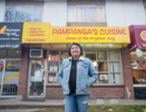C.J. Julien stood before the entrance of the Vancouver Police station at 312 Main Street today, recounting the time a police officer had knocked on her door.
“Is your sister Norma George?” the officer had asked her in September of 1992. When Julien said she was, the officer continued: “We found your sister dead…somebody dumped her in Aldergrove.”
Voice trembling, Julien spoke into a microphone just before 3 p.m. She was the final speaker to address the vast crowd who had come for the 19th annual Women’s Memorial March, despite the whirlwind of Olympic activity.
The ceremony, which always takes place on Valentine’s Day, commemorates the lives of missing and murdered women, particularly those with ties to the Downtown Eastside and aboriginal communities.
“This isn’t a protest or performance,” one volunteer explained to a curious tourist. “This is the real Vancouver.”
As previously reported, a United Nations Committee has highlighted the disproportionate victimization of aboriginal women, stating that their cases “have neither been fully investigated nor attracted priority attention.”
Attention was significant on the streets of the Downtown Eastside this afternoon.
One cycling police officer told the Tyee that the crowd spanned for a solid three blocks. The Vancouver Sun estimates that 800 people attended, while the Canadian Press pegged the number closer to 1,200. Many repeat participants said it was the largest turnout they had ever seen.
The procession began at 1 p.m., departing from the Carnegie Community Centre on the corner of Main and Hastings streets and culminating with a few speeches in front of the Vancouver Police station on Main Street.
During the march, several participants drummed in unison and sang the women’s warrior song. A smaller group of bereaved friends and family members stopped to lay yellow flowers where missing women were last seen, and red roses where the remains of deceased women had been found.
“No photographs at this time,” said a volunteer during one of the silent stops. An onlooker at Abbott and Water streets was loud and defiant at first but put down his camera when he learned the purpose of the march.
Many such restraints were asked of the attendees. For instance, participants were asked not to wear masks on their faces and to leave protest paraphernalia at home. This was done to distinguish the memorial from ongoing protests, and to honour it as “a deeply emotional time.”
Although the overall mood was somber, there were moments of collective joy. At Carrall and Hastings streets, several people began pointing up at the sky.
“Do you see the eagles?” one man called out as cheers erupted from the crowd. “Right there, two of them! They’re circling high above in front of the clouds.”
Julien, who said her Indian name is Shining Eagle Woman, saw the birds as ancestors and sisters witnessing the ceremony. She also acknowledged all the observers at the ground level.
“The world is visiting us. Thank God that they’re going to be witnessing what we’re doing for our First Nations,” she said.
Fabiola Carletti is covering the Olympics as part of her practicum at The Tyee.










What have we missed? What do you think? We want to know. Comment below. Keep in mind:
Do:
Do not: